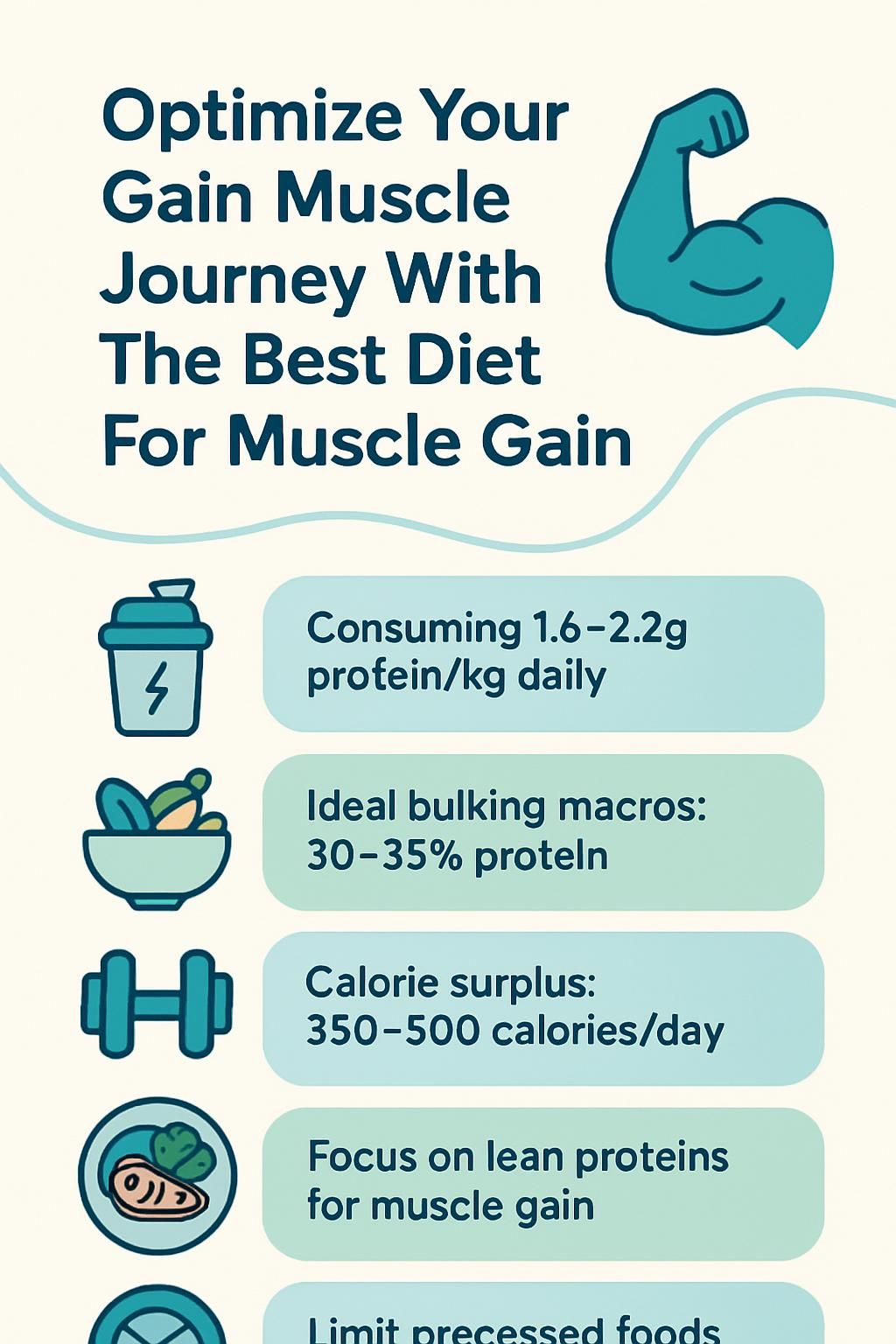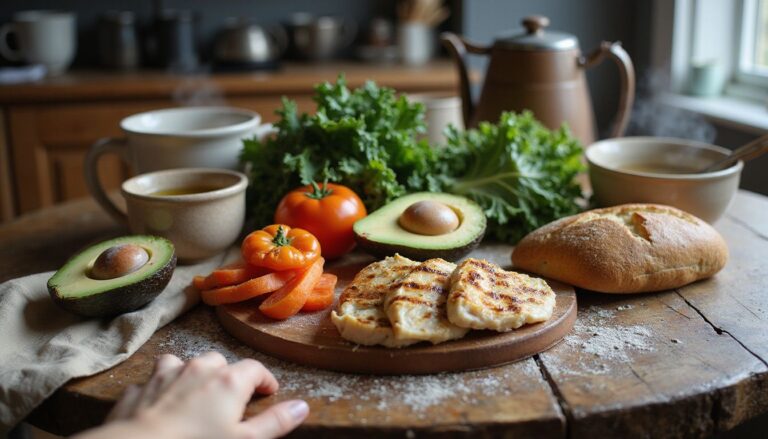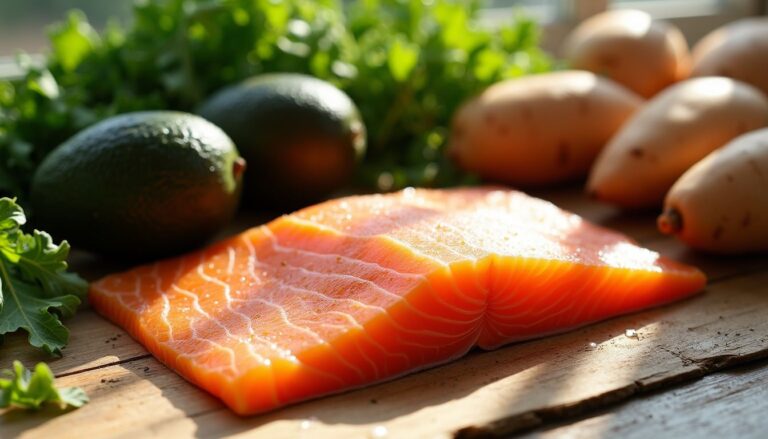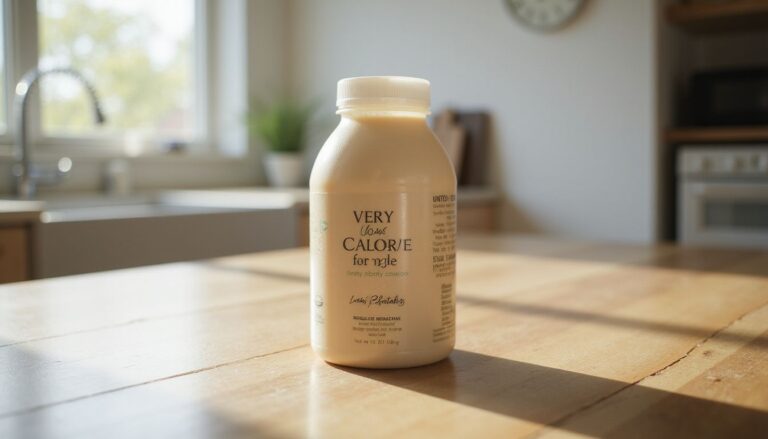Optimize Your Gain Muscle Journey With The Best Diet For Muscle Gain
Our Nutrition Assistant AI Suite will transform your body. You will lose fat, get toned, and build muscle. Gain confidence and optimal health.
You train hard yet the scale barely moves. If you want to gain muscle and build strength, the right meals matter as much as your workouts. A steady plan, built on the best diet for muscle gain, turns effort into visible results.
This guide shows you how to choose protein, carbohydrates, and fats to grow lean muscle mass while meeting your calorie and protein needs. You will learn simple ways to support muscle growth and repair with every meal and snack.
Keep reading to see which small changes help you build muscle faster and feel stronger in the gym.
Key Takeaways
- Daily protein of 1.6 to 2.2 grams per kilogram of body weight supports muscle mass during strength training; see Morton et al., 2018.
- For bulking, a common target is 30 to 35 percent protein, 55 to 60 percent carbohydrates, and 15 to 20 percent fat with a surplus of about 350 to 500 calories per day.
- Lean proteins such as chicken breast, Greek yogurt, eggs, tofu, and fish help build muscle while limiting saturated fat.
- Focusing on whole foods and limiting added sugars, ultra-processed items, and alcohol supports recovery and long-term health, according to Harvard T.H. Chan School of Public Health.
- Evidence-based supplements like third-party tested whey protein and creatine can help, but they do not replace balanced meals or personal guidance.

Why is Diet Essential for Muscle Gain?

Diet fuels training and gives your body the materials it needs to build new muscle fibers. Enough calories and protein are required to trigger muscle protein synthesis, the process that builds muscle tissue. Research suggests 1.6 to 2.2 grams of dietary protein per kilogram of body weight per day supports gains in muscle mass during strength training1.
Eating nutrient-dense foods supplies energy for hard sessions and the vitamins and minerals needed for repair. Limiting alcohol, added sugars, and deep-fried foods supports lean mass and lowers chronic disease risk2.
Fill your plate with vegetables, lean proteins, healthy fats, whole grains, and dairy or fortified alternatives. Each meal becomes a chance to gain more muscle.
Nutrition has the single largest influence on gaining muscle mass outside of resistance training,says sports nutritionist Nancy Clark.
1 Morton RW et al., British Journal of Sports Medicine, 2018. 2 Harvard T.H. Chan School of Public Health, The Nutrition Source.
Key Components of a Muscle-Building Diet
Your gain muscle plan starts with what you eat each day. A balanced approach fuels workouts, supports muscle hypertrophy, and speeds recovery between sessions.
What Role Does Protein Play in Building Muscle?
Protein supplies amino acids, the building blocks for muscle repair and growth. Active adults often do best with 1.2 to 2.0 grams per kilogram of body weight daily. At 180 pounds, that is about 100 to 160 grams per day.
Choose high quality protein foods like chicken breast, Greek yogurt, eggs, fish, tofu, beans, and whey protein shakes. For example, 3.5 ounces of chicken breast has about 22 grams of protein, and six ounces of Greek yogurt has about 17 grams. Whey protein offers a complete amino acid profile and is fast to digest.
Hitting your protein target helps you recover quicker, reduce muscle breakdown, and lay down new muscle after training.
How Do Carbohydrates Fuel Muscle Growth?
Carbohydrates refill muscle glycogen, your main fuel for intense exercise. Adequate carbs help you train harder and reduce fatigue. If you are trying to build muscle, many lifters do well with 55 to 60 percent of calories from carbohydrates.
Whole grains like oats, quinoa, and brown rice provide steady energy plus extra protein. Fruits, starchy vegetables, beans, and dairy also supply helpful carbs. Carbohydrates have four calories per gram and are vital for performance and recovery.
Why Are Healthy Fats Important for Hormone Production?
Healthy fats support hormone production, including testosterone, which helps muscle mass and strength. Favor unsaturated fats from olive oil, avocado oil, nuts, seeds, and fatty fish. Omega-3 fats from salmon, flax seeds, and chia seeds may help manage inflammation after hard sessions.
Dietary fat provides nine calories per gram. A practical range for many lifters is 15 to 20 percent of daily calories.
Which Vitamins and Minerals Aid Muscle Recovery?
Vitamins and minerals help your body convert food into energy and repair tissues. Vitamin C from leafy greens, tomatoes, and broccoli supports healing. Iron and magnesium from beans and lentils aid oxygen transport and muscle function.
Potassium in milk or cottage cheese helps prevent cramps. Calcium supports bones, which carry heavier loads as you grow stronger. Vitamin D improves calcium absorption, so consider fortified foods or safe sunlight if you train indoors.
Calculating Your Calorie and Macronutrient Needs
Dialing in calories and macronutrients helps you grow muscle without adding too much body fat. A simple system keeps you on track.
How Do You Calculate Your Calorie Requirements?
- Weigh yourself three times per week. Stable weight signals maintenance calories.
- Log food and drink with a calorie-tracking app. Accurate tracking reveals true intake.
- Find your weekly average intake while weight stays steady, then set that as maintenance.
- For muscle gain, add about 15 percent above maintenance. If you maintain at 3,000 calories, aim near 3,450.
- Use a daily surplus of 350 to 500 calories to support muscle without excess fat gain.
- Recheck needs every month as weight, steps, and training volume change.
- Target weekly gains of 0.5 to 1 percent of body weight to favor lean mass.
- Set macros with protein first, then carbs for training, then fats to fill remaining calories.
- Use guidance from systematic reviews and a qualified dietitian for fine tuning.
Last summer I followed this approach for a gym challenge. Tracking weekly and logging meals helped me add lean size while keeping fat in check.
This method supports increasing muscle while limiting unwanted weight gain.
What Are the Ideal Protein, Carbohydrate, and Fat Ratios?
Balanced macronutrients support training, recovery, and hormone health. The table shows common targets for bulking and cutting phases.
| Diet Phase | Total Calories | Protein | Carbohydrates | Fat |
|---|---|---|---|---|
| Bulking | 3,450 kcal | 259–302 g (30–35% of calories) | 474–518 g (55–60% of calories) | 58–77 g (15–20% of calories) |
| Cutting | 2,550 kcal | 191–223 g (30–35% of calories) | 351–383 g (55–60% of calories) | 43–57 g (15–20% of calories) |
- Protein and carbohydrates provide 4 calories per gram. Fat provides 9 calories per gram.
- Aim for at least 1.4 grams of protein per kilogram of body weight.
- Higher carbohydrate intake fuels hard training and aids recovery between sessions.
- Fat supports hormones and adds energy density to reach calorie goals.
- Consult a registered dietitian to customize these ratios for your needs.
Best Foods for Muscle Growth
Smart choices make it easier to increase muscle mass. Mix lean proteins, complex carbs, and healthy fats to support training and recovery.
What Are the Best Lean Proteins for Muscle Gain?
High quality protein helps you build muscle while limiting saturated fat. Rotate these options to cover flavor, cost, and convenience.
- Chicken breast, about 22 grams of protein per 3.5 ounces, low in fat.
- Tuna, about 20 to 27 grams per serving, rich in key nutrients.
- Salmon, about 20 grams per 3.5 ounces, plus omega-3 fats for recovery.
- Turkey breast, about 26 grams per 3 ounces, easy to digest.
- Pork tenderloin, about 23 grams per cooked 4 ounces, a lean red meat option.
- Sirloin steak, tilapia, shrimp, and lean ground beef, all high in protein when trimmed.
- Tofu, about 9 grams per 3 ounces, and edamame, about 18 grams per cup, for plant-based meals.
These foods help you reach daily protein needs for muscle growth and repair without excess saturated fat.
Which Complex Carbohydrates Support Muscle Growth?
Complex carbohydrates provide steady energy and fiber. They also bring extra protein and minerals to your plate.
- Oats, about 6 grams of protein per cup, slow to digest for lasting fuel.
- Brown rice, about 6 grams of protein per cup, supports recovery.
- Quinoa, about 8 grams of protein per cup, contains all essential amino acids.
- Buckwheat, about 6 grams of protein per cup, gluten free and filling.
- Sweet potatoes, rich in vitamins and great for refilling glycogen stores.
- Whole grain bread and cereal, steady energy with fiber for digestion.
- Beans and chickpeas, about 15 grams of protein per cup, plus complex carbs.
- Corn and green peas, starchy vegetables with helpful vitamins and fiber.
- Potatoes, a simple way to add potassium and energy for training days.
Pick whole food carb sources most of the time. They help you train hard and recover well.
What Healthy Fats Should You Include in Your Diet?
Healthy fats aid nutrient absorption and hormone production. Add a small amount to each meal for balance.
- Olive oil for salads or light cooking, supports heart and hormone health.
- Avocado oil for higher-heat cooking, rich in monounsaturated fats.
- Flaxseed oil for smoothies or dressings, a plant source of omega-3s.
- Fatty fish like salmon several times per week, protein plus omega-3s.
- Nuts and seeds, such as almonds, peanuts, walnuts, sunflower, chia, or flax.
- Pumpkin seeds, about 8 grams of protein per ounce with key minerals.
- Chia or ground flax in oatmeal or shakes for extra omega-3s.
- Sunflower seeds for healthy fats and vitamin E.
These choices help you meet fat goals without relying on sweets or fried foods.
What Dairy or Alternatives Are Good for Muscles?
Dairy and fortified plant milks offer protein, calcium, and vitamin D. They fit well in many meal plans.
- Greek yogurt, about 17 grams of protein per 6 ounces, convenient post-workout.
- Cottage cheese, about 12 grams per cup for 2 percent, higher in regular versions.
- Low fat milk, a mix of protein and carbs that supports lean mass.
- Cheese, adds calcium and fat, use small portions for snacks.
- Yogurt, choose low sugar options to control calories while getting protein.
- Cow’s milk, about 8 grams of protein per cup for muscle repair.
- Fortified soy or pea milk, similar protein per serving, check calcium and vitamin D.
- Pairing cottage cheese with nuts at night can improve overnight satiety.
Choose plain options and add fruit or spices to manage sugar intake.
Foods to Avoid or Limit for Muscle Gain
Certain foods stall progress. Cutting back on them frees room for meals that support training and recovery.
Why Limit Added Sugars When Gaining Muscle?
Foods high in added sugar, such as candy, soda, pastries, and sweetened drinks, add calories without useful nutrients. These choices do little to support muscle growth or recovery.
Extra sugar often becomes stored fat, which can make body composition harder to manage. Swapping sweet drinks for water or milk helped my own training energy and focus.
Choose nutrient-dense foods most of the time. You will see better training results and steadier energy.
How Do Processed and Fried Foods Affect Muscle Growth?
Deep-fried items like fries, onion rings, and breaded meats can increase inflammation. Ultra-processed foods, such as sugary cereals or processed meat, offer little support for protein synthesis or recovery.
Greasy foods also slow digestion and may limit nutrient absorption. Prioritize lean protein, whole grains, fruits, and vegetables to protect your progress.
Consider the impact of alcohol as well. It can interfere with muscle building and fat loss efforts.
What Are the Effects of Alcohol on Muscle Gain?
Alcohol disrupts protein synthesis, the process your muscles need after training. It can lower testosterone and raise cortisol, which both work against muscle building.
Alcohol adds empty calories and can delay recovery. Reviews show excess intake limits lean mass gains even with solid training and diet habits. Limiting alcohol supports better results.
Why Avoid Low-Nutrient Snacks?
Low-nutrient snacks, such as fried foods, candy, soda, and processed meats, pack calories without the vitamins and minerals needed for recovery. A donut might have more than 250 calories yet almost no protein.
Choosing nutrient-dense snacks, like Greek yogurt or fruit with nuts, gives your muscles what they need to repair after lifting. Research from Harvard’s Nutrition Source links higher quality protein foods with better gains in lean mass.
Incorporating Supplements for Muscle Growth
Supplements can help if your base diet is already strong. Use them to fill gaps, not to replace meals.
What Are the Best Protein Powder Options?
- Whey protein is fast to digest and has all essential amino acids. It is a popular choice for post-workout recovery.
- Pick third-party tested products to minimize contamination risks and confirm label accuracy.
- Casein digests slowly, so it works well before bed to support overnight recovery.
- Plant-based powders like soy or pea can work for dairy-free or vegan diets. Blends can help cover all essential amino acids.
- Hydrolyzed whey absorbs quickly but often costs more. Athletes with very high training loads may prefer it.
- Use powders to hit protein goals when food alone falls short.
- Speak with a healthcare professional before starting new supplements, especially if you have health conditions or allergies.
Choose products that match your goals, budget, and tolerance.
How Does Creatine Help Strength and Recovery?
Creatine monohydrate increases phosphocreatine stores in muscle. This boosts short bursts of energy, so you can do more reps and sets.
Studies show creatine improves strength and can reduce fatigue between sets. Many lifters see progress within a few weeks when they take it consistently.
What Are Branched-Chain Amino Acids (BCAAs)?
BCAAs are leucine, isoleucine, and valine. They are essential amino acids, which means your body cannot make them. You get them from foods like chicken, eggs, fish, dairy, or supplements.
Research on BCAA supplements is mixed. Many people meet their BCAA needs by getting enough total protein from whole foods or whey. Focus on total daily protein first.
Should You Take Multivitamins and Omega-3s?
Multivitamins can cover small gaps if your food intake misses key micronutrients. Training phases with high volume may increase needs for certain vitamins and minerals.
Omega-3s support heart health and may ease post-workout soreness. Fish oil is common, and fatty fish like salmon offers about 1.5 grams of omega-3s per 3-ounce serving.
These additions can support recovery. Still, they work best on top of a balanced eating plan.
Sample 7-Day Meal Plan for Muscle Gain
A simple weekly meal plan helps you hit your calorie and macronutrient targets. Use this sample as a starting point, then adjust portions to match your needs.
What Does Day 1’s Muscle Gain Meal Plan Look Like?
Breakfast: scrambled eggs, whole grain toast, and oats. One egg supplies about 6 grams of protein, and a cup of oats adds another 6 grams. Mid-morning, have Greek yogurt with berries for protein and antioxidants.
Lunch: grilled chicken sandwich on whole grain bread with leafy greens. A 3.5-ounce serving gives about 22 grams of protein. Afternoon snack: a handful of almonds adds 6 grams of protein and healthy fats.
Dinner: baked chicken or fish with brown rice and steamed vegetables. A banana for dessert helps refill energy. This day balances lean proteins, complex carbs, fruits, and nuts.
What Are the Meals for Day 2?
Breakfast: egg whites with sliced turkey and a side of sweet potatoes for complex carbs and potassium.
Lunch: grilled chicken with brown rice and broccoli. Brown rice offers slow energy for the afternoon.
Snack: cottage cheese with edamame for an easy protein boost.
Dinner: lean ground turkey chili with beans. Beans add fiber and plant protein. If you want a small snack before bed, choose nuts for healthy fats and satiety.
What Should You Eat on Day 3?
Breakfast: oatmeal with Greek yogurt and fresh berries. This mix provides protein, carbs, and antioxidants.
Lunch: grilled salmon for about 20 grams of protein per 3.5 ounces plus omega-3s. Add quinoa for extra protein and fiber.
Snacks: cottage cheese or low fat milk to supply casein protein for recovery. Add avocado or drizzle olive oil on meals to cover healthy fat needs.
What’s Included in Day 4’s Meal Plan?
Protein focus: chickpeas at lunch or dinner, about 15 grams per cup, plus lean meats like chicken breast. Greek yogurt adds protein and calcium.
Carb focus: whole grain cereal at breakfast and sweet potatoes later in the day for steady energy.
Fat focus: seeds or nuts as snacks, such as almonds or sunflower seeds, to support hormone health.
What Are the Foods for Day 5?
Protein focus: tofu at one meal and lean beef at another to raise protein intake. Tofu offers about 9 grams per 3 ounces.
Carb focus: brown rice or quinoa to fuel workouts and recovery. Add colorful vegetables like broccoli and peppers for vitamins.
Snack ideas: seeds or nuts for healthy fats. Fruit such as berries or oranges for antioxidants and fiber.
What Does Day 6’s Meal Plan Include?
Main protein: pork tenderloin at lunch or dinner. Four ounces provides about 23 grams of protein for repair and growth.
Support foods: beans for extra plant protein and fiber, cottage cheese for protein and calcium. Choose quinoa or roasted sweet potatoes for complex carbs at main meals.
Cooking fats: olive oil or avocado oil for essential fats and flavor.
Here is a sample breakdown for Day 6:
| Meal | Protein Source | Complex Carb | Healthy Fat |
|---|---|---|---|
| Breakfast | Cottage cheese | Quinoa | Olive oil |
| Lunch | Pork tenderloin | Sweet potato | Avocado oil |
| Snack | Beans with vegetables | Whole grain crackers | — |
| Dinner | Pork tenderloin | Roasted vegetables | Olive oil |
This structure uses lean proteins, slow-digesting carbs, and quality fats at every meal.
What Meals Are Planned for Day 7?
Breakfast: scrambled eggs with whole grain toast and fruit. Add Greek yogurt for extra protein and calcium.
Lunch: grilled lean game meat or another lean red meat, about 22 grams of protein per 3 ounces cooked. Pair with brown rice and roasted vegetables.
Snack: sliced fruit with a handful of almonds. Dinner: baked chicken breast with sweet potatoes and a side of spinach or broccoli. End the day with cottage cheese or Greek yogurt to support overnight repair.
Pre- and Post-Workout Nutrition Tips
Smart timing turns good foods into great training fuel. Think of pre-workout meals as the spark and post-workout meals as the reset.
Why Are Pre-Workout Carbs and Proteins Important?
Carbohydrates top up glycogen so you can lift heavier and train longer. Many athletes do well eating 1 to 4 grams of carbs per kilogram in the hour before training, based on sports nutrition guidance.
Protein before exercise reduces muscle breakdown and supports repair. A target of 0.2 to 0.4 grams of protein per kilogram before training can help.
To limit stomach upset, choose lower fat, lower fiber options like Greek yogurt with a banana or chicken with rice cakes. Caffeine from coffee or tea may boost focus and reduce fatigue for some people.
How Should You Recover Post-Workout with Nutrition?
After lifting, aim for 20 to 30 grams of high quality protein within about 30 minutes. Whey protein or grilled chicken both work well.
Add a fast digesting carbohydrate, such as a banana or white rice, to restore glycogen. Research shows that protein plus carbs post-workout helps repair and growth more than either alone.
Hydrate with 16 to 24 ounces of water for every pound lost during exercise. A simple shake with whey and oats leaves many lifters less sore and more ready for the next session.
Potential Risks and Challenges in Muscle Gain Diets
Muscle gain plans can miss the mark if calories, protein goals, or supplements are off. A few checks can prevent setbacks.
What Are the Risks of Overeating or Undereating Calories?
Eating too far above maintenance can add fat faster than muscle. A surplus of 250 to 500 calories per day usually supports growth without rapid fat gain.
Cutting calories too hard can lead to muscle loss and slower recovery. Adjust intake monthly based on body composition, training quality, and energy levels.
What Are Common Misconceptions About Protein Intake?
More protein is not always better. Many people do well near 1.4 grams per kilogram of body weight, adjusted for training load.
Relying only on shakes can crowd out benefits from whole foods like chicken, fish, yogurt, tofu, and beans. A mix of foods and supplements works best for most people.
Why Is Supplement Use Risky Without Proper Guidance?
In the United States, supplements are not pre-approved for safety or quality. Some products may be contaminated or mislabeled.
Bold marketing claims can mislead. Certain ingredients have weak evidence for real-world results. Work with a healthcare professional to choose safe, effective options and proper doses.
Benefits of Optimized Muscle Gain Diets
A well-planned diet helps you train harder, recover faster, and steadily increase muscle mass. Small daily wins build up over time.
How Does an Optimized Diet Enhance Muscle Growth?
Protein provides building blocks for new tissue. Studies suggest at least 1.6 grams per kilogram each day maximizes muscle growth for many lifters.
Complex carbs fuel training and recovery. Balanced calories and macros let you push harder in the gym and repair between sessions. A simple plan built on chicken, fish, tofu, quinoa, greens, and yogurt can deliver results within weeks.
What Are the Recovery and Performance Benefits?
Enough protein and calories speed muscle repair after strength and cardio sessions. Nutrient-rich foods lower injury risk and help you feel ready for the next workout.
Extra carbs like sweet potatoes, paired with protein, support faster recovery. Consistent hydration keeps muscles functioning well and reduces cramps and fatigue.
References: Journal of Strength & Conditioning Research, 2020; American College of Sports Medicine Guidelines, 2017.
What Long-Term Health Benefits Come from a Muscle Gain Diet?
Healthy eating patterns plus regular exercise can protect against heart disease, some cancers, and kidney problems. They also support immune function and a steady metabolism.
People often report more energy for daily tasks and training. Over time, this approach supports a longer health span, not just a better physique.
Conclusion
Optimizing your muscle gain journey starts with consistent meals built around lean protein, complex carbohydrates, and healthy fats. Track calories, adjust portions as your weight and activity change, and aim for steady progress.
Use evidence-based supplements like whey protein and creatine if they fit your needs. They can help, but they never replace balanced meals. For medical conditions, specific nutrient needs, or supplement questions, seek advice from a registered dietitian or a healthcare professional.
With the best diet for muscle gain in place, you build muscle, recover faster, and support long-term health throughout every phase of training.
FAQs
1. What is the best diet for muscle gain?
A balanced eating plan for building muscle includes lean animal protein, whole grains, healthy fats, and plenty of fruits and vegetables. Research shows that consuming 1.6 to 2.2 grams of protein per kilogram of body weight each day supports optimal muscle growth (Phillips & Van Loon, 2011). Carbohydrates help fuel workouts while fats support hormone production.
2. How often should I eat to maximize muscle gain?
Eating every three to four hours helps maintain a steady supply of nutrients for your muscles. Studies suggest spreading protein intake across meals increases muscle synthesis compared with eating most protein at one meal (Areta et al., 2013).
3. Which foods should I avoid on a diet for gaining muscle?
Limit processed snacks high in sugar or saturated fat as they offer little nutritional value and may hinder progress toward your goals. Focus instead on nutrient-dense options such as eggs, poultry, fish, beans, brown rice, oats, nuts, seeds, leafy greens, and berries.
4. Can personal experience guide my food choices when trying to build more strength?
Personal experience can help you identify which foods give you energy during training sessions or aid recovery after exercise. For example; after switching from white bread sandwiches to whole grain wraps with turkey breast and spinach before workouts last year I noticed improved stamina during resistance training.
Summary:
A well-structured nutrition plan rich in lean animal proteins like chicken or fish along with complex carbohydrates such as brown rice supports effective strength development when paired with regular meals throughout the day; avoiding highly processed items further enhances results according to scientific evidence and practical application alike.






